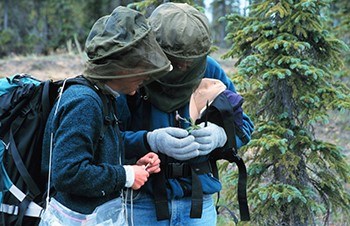
NPS
Contact: Stefanie Ickert-Bond
Duration: 3 years
Collaborators: The Komarov Botanical Institute in St. Petersburg, Russia; the Natural History Museum of Oslo, Norway
Location: Seward Peninsula, Alaska
Many state and federal agencies conduct botanical studies in Alaska, and the more closely their taxonomic determinations are aligned, the more opportunities there are for transparent sharing of results and research synthesis. Because many years have passed since the last state-wide flora was completed, and because the extensive new taxonomic research on the plants of Alaska is published in multiple locations, each agency has drawn up their own policy on name usage. Completing a new Flora of Alaska, which is now a major goal of the UAF herbarium, the principal institution handling the taxonomy of Alaskan plants, will permit greater taxonomic standardization among all researchers in Alaska.
It is impossible to understand fully the origin of Alaska’s flora without knowing a great deal about its Russian (i.e., Asian) elements. Many plant taxa arrived in Alaska from continental Asia via the Bering Land Bridge as it was exposed during successive intervals of continental glaciation during the Ice Ages. During the Last Glacial Maximum (LGM) rapid climate change drove episodes of biotic expansion, interchange, isolation, diversification and extinction on varying temporal and spatial scales. Boreal climates and landscapes changed repeatedly during the Pleistocene, affecting the movement of native taxa. These movements had large impacts on the genetic and taxonomic diversity of present-day flora and fauna producing a biotically distinctive region known as Beringia.
For over 20 years North American, Russian, and European taxonomies have been collected, synthesized and shared through in the Panarctic Flora project efforts and website. However, this dataset has not been updated in 8 years, and its web presence is lagging behind modern presentations of taxonomic data.
Russian/international component:
This project brings together experts from Russia, Norway and Alaska with the goal to upgrade the Panarctic Flora content, and its core database structure and web presentation. The project team will also produce a monograph of the plants of the Seward Peninsula with chapters on the history of plant collecting and Beringian history as it relates to the plants.
Last updated: March 19, 2021
